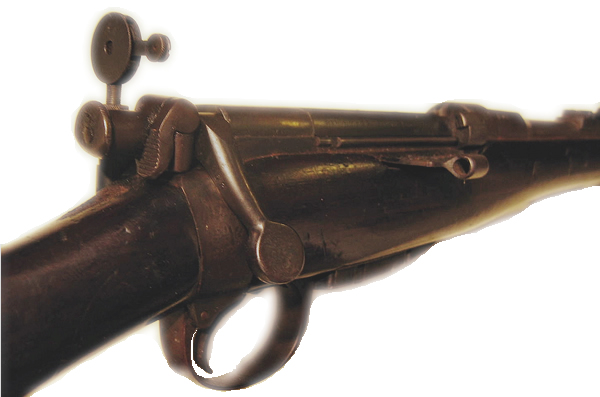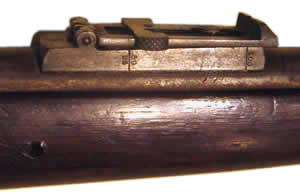
Early versions of the Lee-Metford and Lee-Enfield bolt-action rifles that were sold commercially were required to carry acknowledgement of the patent holders for the designs used. The inventor of the bolt-action was the Scottish-born and renowned James Paris Lee, who lived for all but the first four or five years of his life initailly in Ontario, and latterly in Toronto, Canada, with his magazine-fed bolt-action design being first put into significant production in conjunction with the Remington Arms Company. He died in 1904.
J.J. Speed (Joseph) was a senior manager at the Royal Small Arms Factory at Enfield Lock between 1891 and 1909. He was closely involved in the production and manufacture of the Lee-actioned rifles for the British military, and made improvements to the action, whilst working at the factory on the designs, which were controversially patented in his name. It did subsequently become customary though for the factory Superintendents to make the applications for designs and alterations made at the RSAF.
Those rifles built by various manufacturers for commercial sale were thus marked " LEE-SPEED PATENTS" until such time as the patents expired or were superseded.
One of the major producers of Lee-actioned rifles in Britain was the Birmingham Small Arms Company. The RSAF only manufactured rifles for service use, leaving the commercial market to the likes of B.S.A., who manufactured both for military contracts and commercial sales.
B.S.A. marketed the rifles by printing catalogues detailing their models available to the public, but did not get involved in retailing their arms and accessories, leaving that to those gunsmiths and department stores already well-know for the sales of guns. One such store was the famous "Army & Navy" then, and still, situated in Victoria Street, London (and not to be confused with the Army and Navy Surplus Store chain). It was to this retailer that many British officers went for the rifles and pistols they desired to take to the French and Belgian battlefields of the First World War, having traditionally used the A&N to purchase their sporting rifles and shot-guns.

Top: the Officer's Model No.2 marketed by the Army & Navy Stores Ltd., London, circa 1908/14. (See page 14 of the B.S.A. catalogue for 1909). This particular model was sold with full-length chequered wood furniture, without any fitting for a bayonet, and with the shot-gun style safety-catch (See page 16 of the B.S.A. catalogue for 1909) to suit gentleman more accustomed to game shooting with butt-wrist slide catches than with the Lee-Metford or Lee-Enfield service safety-catch systems .
Bottom: Mk.II Metford Lee-Speed. This has no safety-catch, and is reliant solely upon the "half-cock" action of the bolt's cocking-piece. The barrel is rifled by the radiussed groove Metford system, then still favoured by target shooters for its reduced tendency to foul the barrel with spent propellant residue, rather than by the later Enfield square-edged groove system. These specially built target rifles complied with all rules requiring 'as issued' specification rifles only to be used for competition, but were finished to a far higher standard than miltary issue rifles. (See page 7 of the B.S.A. catalogue for 1909)
Each of these rifles was manufactured by the Birmingham Small Arms Company for commercial sale, and fitted with the familiar pre- charger-loading Long-Lee bolt dust-cover, and forward curved handle of the bolt seen above. This is to permit easy entry into and removal of the carbine from the leather saddle holster. These carbines were fitted only with a five-round magazine, which protruded below the underside of the stocking considerably less than the ten-round standard magazine of the long rifle. Whilst the Long-Lee shown is a purpose-built target rifle, the particular model of carbine illustrated here was specifically intended for use on the battlefield by cavalry officers, who were of course entitled to make their own purchases of selected arms within certain limitations. Other very similar carbines were available for sporting use, but more usually with much shortened fore-end woodwork. (See pages 12 & 13 of the B.S.A. catalogue for 1909)
Above, the high quality of the fore-end and Butt-stock wrist chequering is evident, as are the presence of the magazine cut-off and the Patent and Manufacturer's marks on the butt-socket.
Both the carbine and rifle are in .303" calibre, and are marked respectively on the receiver and barrel reinforce "For Cordite Only"
Further detail images of the carbine are shown below. Click each image for a higher resolution version
The original sling fittings are simple screw-eyes that would have taken the machine-screw swivels of a contemporary webbing or leather sling.
The trigger-guard sling-swivel is a retrofitment,. possibly for target-practice.
Not obvious in the image below, but just visible in the higher resolution image which can be viewed by clicking on this one, the outer face of the bolt-head lug is stamped
PATENT
19.145 '90
 Right, the bolt showing the extractor
Right, the bolt showing the extractor
and dust-cover square mounting points
on the rib of the bolt-body.
 Left, the 1890 Patent of the bolt and head.
Left, the 1890 Patent of the bolt and head.
It is interesting to note the two persons
in whose names the patent application has been made.
F.J. Penn and J. Deeley were possibly at some time associated with, or perhaps may have been employees of the R.S.A.F.;
although there is also the possibilty that they acted entirely as private individuals, since
together they applied for several drop-down type shot-gun action patents from as early as 1885,
about the time that Morris first applied for a very basic patent for his Morris Tube miniature-calibre adaptation.
Deeley, of course, is famous for his joint design, in combination with E.G. Anson, of the box-lock shot-gun action-locking system.
The design of bolt-head here shown in their patent application was carried right through in its basic form
to the last Lee-Enfield rifle, the .22 RF Rifle No.9 made by Parker-Hale for the Royal Navy.
You may here draw a comparison with this latter rifle's bolt-head and those for many other Lee-Enfields, particularly those converted for rim-fire use.
The rifle's serial number "E671" is stamped into the flat on the RHS top of the butt-socket.
The safety-catch slide looks for all the world as though it is mounted on the traditional tang of a shot-gun's action.
However, the 'tang' is entirely separate and mounted onto the rear of the Enfield receiver with a slotted screw.

The patent mark is for B.S.A.'s own patent reference
B.S.A. PAT.
25834 '97
That patent is shown to the right, the sketch indicating how the catch acts under the sear of the trigger tumbler.
This drawing well illustrates the plain cocking-piece, without the bolt-mounted safety lever,
for which the slide safety is the replacement.
Compare this early single-stage trigger with the two-stage version on the later No.4 Lee-Enfield rifle, in its appropriate guise as the Canadian C No.7 training rifle.
The rear-sight is typical of the carbine types, with just 1,2 & 3 stamped on the LHS of the barrel mounting block, representing the short-range graduations for raising the leaf on the ramp for 100,200 and 300 yards. When the leaf is pulled upright for greater distances, the graduates for the elevation slide are for each 100 yard increment from 400 to 1000. There is a fine vertical line under the "V" slot in the slide, inlaid with platinum.
The brass screws - probably not original, these are more likely to have been blued steel - are for the leather rear-sight protector such as can be viewed on the earlier Martini-Metford MT carbine.
The barrel is marked on the LHS with proof and view marks and shows the "NITRO PROVED" stamp indicating the carbine is proved for the later smokeless propellant rather than the Black Powder to which earlier barrels were restricted.
The ramped fore-sight block is machined with an integral barleycorn of substantial proportions, although fine at the top. This design would be more than capable of taking the heavy knocks that might be suffered on a battlefield, as compared with many of the finer sporting fore-sights for use in other fields.
The nose-cap is machined from solid steel, not a pressed item, and is pinned into the underside of the fore-end woodwork. The muzzle crown of this 5-grooved .303" calibre barrel is heavily radiussed.
Below are just a few images of a Claborough & Johnstone .22 rimfire conversion of a Lee-Speed carbine for small-bore training, practice and target shooting.
The link above, or clicking on the image below, will take you to a page carrying greater detail
Any bolt dust-cover originally fitted to the carbine above has long since been removed. The bolt is the original for the carbine, and is of the cocking-piece safety type patented by Joseph Speed, (later manager of the Royal Small Arms Factory at Enfield), and initially fitted both to the Mark I Lee-Metford carbine and subsequently the Mk. II Lee-Metford Magazine Rifle (then notated the Mk.II*) in 1895.

This carbine is fitted with the early bolt-mounted safety-catch as issued with the Mark 1 Lee-Metford rifles

With the removal of the dust-cover, the maker's name has been impressed into the bolt-rib.

Additional miniature range graduations have been added, to the RHS of the rear-sight block, for 25, 50 and 100 yards.
Clicking the image below will take you to the page carrying complete BSA catalogues from 1908 to the 1930s - in PDF format.
Click here for Chronology of Enfield genre Training Rifles, Adapters & Cartridges
Return to: TOP of PAGE
See this website's Raison d'être